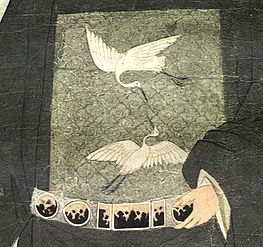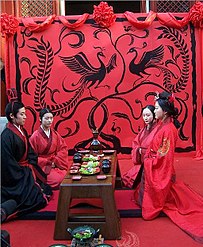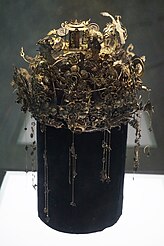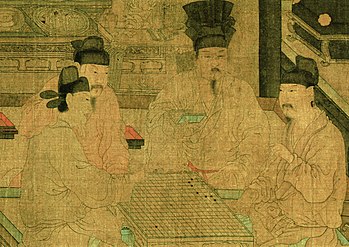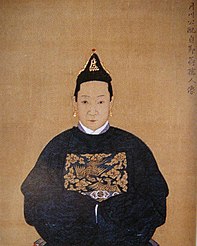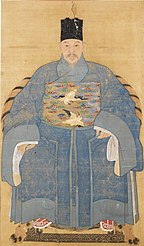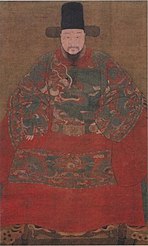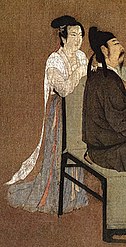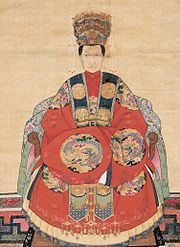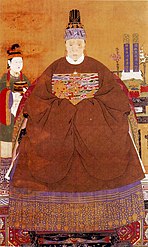Chinese clothing
This article may be a rough translation from Chinese. It may have been generated, in whole or in part, by a computer or by a translator without dual proficiency. (April 2024) |
This article needs additional citations for verification. (April 2024) |
Chinese clothing, including traditional Hanfu, ethnic minority garments, and modern adaptations of indigenous styles, is a vital aspect of Chinese culture and civilization. For thousands of years, Chinese clothing has evolved with dynastic traditions, foreign influences, and cultural exchanges, adapting to the needs of each era.[1] Each dynasty maintained specific styles, colors, and forms that reflected social class distinctions and regional diversity. Beyond its practical functions—such as protection from weather and modesty—clothing also served as a cultural marker, distinguishing social roles, rank, and relationships. Ancient Chinese attire reflected the social and political structures of its time, while also showcasing textile, dyeing, and embroidery techniques. It stands as a testament to the creativity and ingenuity of the Chinese people, as well as the rich intercultural exchanges that shaped its development across centuries.[2]
Origin
[edit]Ancient Chinese literature traditionally credits the invention of clothing to legendary emperors such as Huangdi, Yao, Shun, or Youchao. In primitive societies, clothing was used to symbolize authority and specific identities. For example, as stated in the Book of Changes, Emperor Yao and Shun hung his clothes and ruled the world. The style of their clothing must be different from that of ordinary people. In addition, during military activities or ceremonial rites, the costumes of the host and participants were also different from usual. These laid the foundation for the occurrence and development of the clothing system.[3]
From the perspective of unearthed cultural relics, the origin of clothing history can be traced back to the late Paleolithic period. In ancient times, shoes were often made of animal skin, so the name of the shoe was often referred to as leather. The earliest shoe styles were very rudimentary. It has been speculated that ancient people cut animal skins into rough foot shapes and connected them with thin leather strips to form the most primitive shoes.[4]
Mountain Top Cave Man
[edit]A bone needle and 141 drilled stone, bone, shell, and tooth decorations were found dated 19,000 years old. It was confirmed that natural materials such as animal skins could be used to sew simple clothes at that time. Seven small stone beads and 125 perforated animal teeth and other decorations were seen in the mountaintop cave, with long-term wear and tear marks on them. Among them, 5 pieces were unearthed in a semi-circular arrangement, possibly as strings of decorations. Another 25 pieces were also dyed with hematite powder, and the bones buried in the lower chamber of the mountaintop cave were also scattered with hematite powder particles, which may have been used for coloring clothes or as a finishing ceremony, reflecting a certain aesthetic sentiment of the mountaintop cave people. Protecting life, concealing oneself from the cold, and decorating oneself have all become the main functions of clothing in primitive society.[5]
The Neolithic Age
[edit]By the Neolithic period, spinning wheels became popular.[citation needed] The Yuyao Hemudu site also unearthed a "waist loom", with a cylindrical back loop that could form a natural weaving mouth, as well as a sheng (scroll). With the invention of textile technology, clothing materials became artificially woven fabrics, and silk production also began in the Neolithic Age. The form of clothing has changed and its functions have also been improved. Cloak style clothing such as headscarves and drapes soon became typical attire, with increasingly complex accessories that have had a significant impact on the formation of clothing systems.[citation needed] After the emergence of textiles, headscarves have developed into a standardized clothing style, widely used in a considerable period of time, in vast regions, and among many ethnic groups. They have basically replaced the clothing components of the Paleolithic era and become the coarse form of human clothing. In addition to general clothing, the Neolithic period also discovered crowns, boots, headgear, and accessories from some pottery relics.[6]
Shang dynasty
[edit]In the Shang dynasty, the primary materials for clothing included leather, silk, ramie, and kudzu. The upper class favored naturally dyed silk and leather, while the lower class, due to limited access to silk, primarily used hemp, ramie, and kudzu fibers.[7][8] As textile technology advanced, silk and ramie fabrics became increasingly significant. Artisans developed the skill to weave exceptionally fine silk, create geometric jacquard patterns, and produce ribbed yarn using warp looms. These fabrics were often richly dyed in deep, vibrant colors.[9]
Western Zhou dynasty
[edit]During the Western Zhou dynasty, the hierarchical system was gradually established, and the Zhou dynasty established official positions such as "Si Fu" and "Nei Si Fu", which were in charge of royal attire. According to literature records and analysis of unearthed cultural relics, the Chinese coronal and attire system was initially established during the Xia and Shang dynasties and had been fully perfected by the Zhou dynasty. It was incorporated into the rule of etiquette during the Spring and Autumn period and the Warring States period. To express nobility and dignity, royal officials in different ceremonial occasions should have their crowns arranged in an orderly manner, and their clothing should also adopt different forms, colors, and patterns. From the human shaped cultural relics unearthed during the Zhou dynasty, it can be seen that although the decoration of clothing is complex and simple, the upper and lower garments are already distinct, laying the foundation for the basic form of Chinese clothing.[10]
Qin dynasty
[edit]Women's clothing
[edit]In the Han dynasty, women's clothing also showed a trend of diversification, with the most famous being the "Liuxian skirt". According to the "Miscellaneous Records of the Western Capital", Zhao Feiyan was granted the title of Empress at that time, and her sister sent people to weave upper and lower jackets, forming a magnificent set of clothing. Zhao Feiyan once wore the "Yunying Purple Skirt", also known as the "Liuxian Skirt", which was a tribute from South Vietnam. This kind of skirt is similar to the pleated skirt of today and is very gorgeous.[11]
Three Kingdoms
[edit]Women's clothing
[edit]During the Three Kingdoms period, women's clothing also had unique characteristics, reflecting the aesthetic concepts and cultural styles of that time.
A skirt or robe is one of the common attire for women. This type of dress is mostly long, with a wide hem, creating a dignified and generous atmosphere. The cuffs and stitching of the dress often carry exquisite embroidery, which may be floral, bird and animal, or other auspicious patterns, reflecting women's pursuit of beauty and love for life.
In addition, women also enjoy wearing various hair and headgear to showcase their beauty and elegance. Common hair accessories include hair combs, hairpins, hairpins, etc. These hair accessories are usually made of precious materials such as gold, silver, jade, etc., which may be inlaid with precious gemstones or jewelry, adding charm and charm to women.[12]
Sui and Tang dynasties
[edit]Sui and Tang women are easy to dress up. The "half-arm" that spread from the court lasted for a long time, and later men also wore it. At that time, long towels were also popular. They were made of tusa with silver flowers painted with silver or gold and silver powder. One end was fixed on the chest strap of the half arm, and then put on the shoulder, and swired between the arms, called silk. There are various kinds of women's hair accessories in the Tang dynasty, each with its own name. Women's shoes are generally floral shoes, mostly made of brocade fabrics, coloured silk and leather.[13]
Song dynasty
[edit]Song official uniform
[edit]During the Song dynasty, there were roughly three types of Hanfu: official attire, casual attire, and traditional attire. In the Song dynasty, the fabric of official uniforms was mainly made of silk. Due to the old system of the Five Dynasties, the government would give brocade robes to high-ranking ministers every year, divided into seven different colors such as Song dynasty Lingjiu ball patterned brocade robes. The color of official attire follows the Tang system, with purple attire for third grade and above, red attire for fifth grade and above, green attire for seventh grade and above, and green attire for ninth grade and above. The official attire style is roughly similar to the long sleeved robe of the late Tang dynasty, but the first attire (such as the crown hat) is already a flat winged black gauze hat, called the straight footed fu head, which is a custom attire for rulers and officials. The official attire of the Song dynasty followed the fish wearing system of the Tang dynasty. Officials eligible to wear purple and crimson uniforms were required to wear a "fish bag" around their waist, which contained fish made of gold, silver, and copper to distinguish their official rank. The square and curved collar is also a characteristic of the court attire, which is the decoration of the lower part of the circle placed between the neckline of the court attire. The daily casual wear of officials in the Song dynasty, apart from their official uniforms and uniforms, mainly consisted of small sleeved round necked shirts and soft winged buns with drooping headbands, still in Tang style, but with more convenient casual shoes for daily living. The representative clothing of the Song dynasty's elderly is a wide sleeved robe with a cross necked (cross necked) collar and a Dongpo scarf. The robe is made of dark material with edges to preserve ancient style. The Dongpo scarf is a square tube shaped high scarf, which is said to have been created by the great literary scholar Su Dongpo. It is actually a revival of ancient cloth scarves, which were often worn by the elderly gentry of the Ming.[14]
Song Dynasty Lingjiu Ball Pattern Brocade Robe
[edit]There were also various popular folk costumes in the Song dynasty. Men are popular with futou and drapes, while women are popular with flower crowns and caps. Women's hairstyles and flower crowns were the focus of their pursuit of beauty at that time, best reflecting the changes in attire during the Song dynasty. During the Tang and Five Dynasties, female corollas became increasingly delicate, while during the Song dynasty, corollas underwent further development and changes. Usually, flower and bird shaped hairpins and combs were inserted into hair buns, making everything unusual.[15]
Yuan dynasty
[edit]
The Yuan dynasty was an era of ethnic integration in Chinese history, and the costumes and clothing fully reflected this feature. Genghis Khan, the founder of the Yuan dynasty, built the Khanate since 1206, and after the destruction of Western Xia and Jin, its ethnic composition was mainly dominated by Mongols. Yuan dynasty due to the more acute ethnic conflicts, long in a state of war, textile industry, handicrafts have been greatly damaged. Palace service system for a long time to extend the Song, until 1321 Yuan Yingzong period only with reference to the ancient system, the development of the Son of Heaven and the hundred officials of the upper garment with the lower garment, on the tight under the short, and in the waist plus crease accumulation, the back of the shoulder to hang a large bead of the “quality of the zhisun” system, the Han people say “one color clothes” or “quality of the zhisun”. This is inherited from the Han and Mongolian national characteristics of the clothing system.[16]
Ming dynasty
[edit]Ming official uniform
[edit]After the rule of the Mongols in the Yuan dynasty, the Han tradition was restored in the Ming dynasty, and Ming Taizu Zhu Yuanzhang re established the Hanfu clothing system. The Ming dynasty emperor wore a black veil folded over a scarf (with black veil wings and a crown), and the hat wings stood up from the back. In the early Ming dynasty, it was requested to restore the Tang style of clothing and headgear. The style of the legal attire was similar to that of the Tang dynasty, except that the imperial crown for advancing talents was changed to a Liang crown, and the crown styles such as the Zhongjing crown were added. Since the Tang and Song dynasties, dragon robes and yellow have been exclusively used by the royal family. Since the Southern and Northern Dynasties, purple has been considered expensive for official uniforms. In the Ming dynasty, due to the emperor's surname Zhu, Zhu was chosen as the official color. Additionally, due to the mention in the Analects of Confucius that "evil purple is the way to seize Zhu," purple was abolished from official attire. In the Ming dynasty, public uniforms were also made of Futou and round necked robes, but at this time, Futou was painted with black paint on the outside, with short and wide feet, and was called Wusha hat. Non official civilians were not allowed to wear it. The most distinctive feature of public uniforms is to use "patches" to indicate the grade, in addition to the color according to the grade regulations. A patch is a piece of silk material approximately 40–50 centimeters square, woven and embroidered with different patterns, and then sewn onto official clothing, with one on the chest and one on the back. Civil officials use birds as their complement, while military officials use beasts, each divided into nine levels. To commend the achievements of officials, clothing such as python robes, flying fish uniforms, and bullfighting uniforms are specially given. The python is a four clawed dragon, the flying fish is a python with fins on its tail, and the bullfighter adds curved horns to the python's head. When reaching the highest rank, jade belts are used. So the "python robe and jade belt" became the most prominent attire of high-ranking officials at this time. Ordinary round necked robes are distinguished by the length of the clothes and the size of the sleeves, with the older ones being respected. The wives and mothers of officials who were granted official titles also wore red long sleeved dresses and various types of Xia Pi, which were differentiated by patterns and decorations. In addition, high-heeled shoes are already worn by upper class women, and there are two types of shoes: inner high sole and outer high sole. The clothing of both upper and lower levels of society has obvious levels.[17]
Cultural Protection
[edit]In the field of cultural preservation, recent research has highlighted the effectiveness of modern digital technologies, such as CLO3D, in recreating traditional Chinese clothing from the Ming dynasty. This innovative approach allows for precise modeling of fabric texture, color, and garment structure, providing a valuable tool for historians and cultural preservationists[18] (Yang et al., 2021). These developments are significant as they offer new methods for accurately preserving and understanding historical garments, which were previously reliant on traditional replication techniques. This intersection of technology and historical study presents an exciting advancement in the conservation of cultural heritage, making it an important addition to related Wikipedia pages.[19]
Qing dynasty
[edit]
The Qing dynasty time to implement shaved hair and easy to dress, Shunzhi nine years (1652), the “dress color shoulder ordinance” promulgated, since the abolition of the Ming dynasty's crowns, gowns, and all the costumes of the Han, but the Manchu dress at the same time absorbed the texture pattern of the Ming dynasty dress. Ming dynasty men were all stored hair in a bun, wearing loose clothing, wearing stockings, shallow shoes; Qing dynasty, shaved hair and braids, braids hanging behind the head, wearing thin horseshoe-sleeved arrows, tight socks, deep boots. But the official and the people's costumes are always clear-cut. The Qing dynasty is a Manchu ruler-based regime, Manchu Banner dress with the change of dynasty rushed into the customs. The customs and habits of the Banners influenced the vast Central Plains. Starting from the public dress gradually pushed to the regular dress.
Republic of China
[edit]The Republic of China period was an important stage in the history of Chinese fashion. Chinese society experienced many changes and revolutions, and Western clothing and styles gradually affected China's fashion industry. China began to be exposed to Western culture and fashion. During this period, some Chinese began to wear Western-style clothing, while traditional Hanfu gradually faded out of the mainstream. Fashion during the Republic of China is considered [by whom?] the origin of modern fashion in China.
Cheongsam
[edit]Cheongsam is the traditional dress of Chinese women in China and the world, and is regarded [by whom?] as China's national treasure and women's national costume. It was formed in the 1920s and has since become the most common women's garment. Some scholars [who?] believe that its origin can be traced back to the deep clothes of the pre-Qin and Han Dynasties. There are still many controversies about its definition and the time of its creation. In 1929, the government of the Republic of China promulgated the Regulations on the System of Clothing, which designated the traditional Chinese jacket and skirt, as well as the cheongsam, as women's dresses.[20]
Zhongshan suit / Mao suit
[edit]Zhongshan suit is a four-pocket garment with a stand-up lapel and a pocket flap designed on the basis of widely absorbing European and American costumes and synthesizing the characteristics of Japanese student clothes and Chinese clothes. In April 1929, the Chinese Zhongshan suit was announced as the legal uniform by order of the Nationalist Government. after the 1950s, it became the formal clothing for everyone from national leaders to ordinary citizens. After the 1950s, Zhongshan suit became the official clothing of the national leaders to the common people.
Early in the People's Republic, Mao Zedong inspired Chinese fashion with his own variant of the Zhongshan suit, which would be known to the west as Mao suit. Meanwhile, Sun Yat-sen's widow, Soong Ching-ling, popularized the cheongsam as the standard female dress. At the same time, clothing viewed as backward and unmodern by both the Chinese as well as Westerners, was forbidden.
In 1949, the First Plenary Session of the Chinese People's Political Consultative Conference (CPPCC) opened with the election of Mao Zedong as Chairman of the Central People's Government, announcing the birth of the great new China at the founding ceremony of the People's Republic of China. In this historic moment, Mao Zedong wearing Zhongshan suit on the Tiananmen Square tower solemn declaration of the image of forever in the history books, and this set of clothes with the world famous, Westerners called it “Mao Suit” (Mao uniform). The Mao Suit became the most fashionable dress of that era. Compared with the Zhongshan Suit of the Republic of China, the Mao Suit of the 1950s had a larger neckline and the lapel changed from small to large.[21]
The first People's Congress in 1954, men are to wear the Zhongshan suit as fashionable and progressive. While most of the women choose Su Lenin suit, this style of clothing learned from the Soviet Union for the double-breasted suit with open collar, if the lower part of the large lapel phase cover, buckle under the collar, it becomes two small pointed collar. The waist tied a cloth belt, two rows of three buttons, double lapel in the lower part of both with a dark slanting pockets, using gray or blue khaki, this system of clothing can shape the typical “female cadres” image, in the revolutionary era looks simple and solemn.[22]
Around the Destruction of the "Four Olds" period in 1964, almost anything seen as part of traditional Chinese culture would lead to problems with the Communist Red Guards. Items that attracted dangerous attention if caught in the public included jeans, high heels, Western-style coats, ties, jewelry, cheongsams, and long hair.[23] These items were regarded as symbols of bourgeois lifestyle, which represented wealth. Citizens had to avoid them or suffer serious consequences such as torture or beatings by the guards.[23] A number of these items were thrown into the streets to embarrass the citizens.[24]
Modern Fashion
[edit]On the one hand, fashion styles in China tend to be diversified, and since 2023, styles such as “Dopamine,” “New Chinese style” have been hot, reflecting the diversity of contemporary fashion and the This reflects the diversity of contemporary fashion and the young generation's pursuit of personalized expression. Consumers' understanding of fashion has gradually gone beyond simple trend-following, paying more attention to the expression of personality and emotion through clothing, and the style of clothing has become more versatile. It is worth paying attention to the fact that traditional clothing containing classical aesthetics, such as Hanfu and Tang suit, have continued to be popular among consumers in recent years. Data show that the Hanfu, show clothes turnover year-on-year growth rate of 376% and 212%, respectively, the number of consumers of men's Tang suit increased by more than 90% year-on-year.On the other hand, fashion styles tend to diversify. These unique styles are not only changes in the matching of clothing and apparel, but also the display of life attitude and cultural symbols. On the other hand, consumers' attention to materials and fabrics has driven the quality upgrade of the fashion industry. “Soft and comfortable”, “not easily deformed”, “multi-color optional”, “windproof and warm” and so on have become popular apparel keywords which highlights consumers' high demand for clothing quality. This concern for quality is not only reflected in the appearance, but also shows the importance of the wearing experience and environmental protection characteristics of clothing.[25]
Hong Kong clothing brand Shanghai Tang's design concept is inspired by historical Chinese clothing. It set out to rejuvenate Chinese fashion of the 1920s and 30s, in bright colors and with a modern twist.[26][27] Other Chinese luxury brands include NE Tiger,[28] Guo Pei,[29] and Laurence Xu.[30]
In the year 2000, dudou-inspired blouses appeared in the summer collections of Versace and Miu Miu, leading to its adoption within China as a revealing form of outerwear.
For the 2012 Hong Kong Sevens tournament, sportswear brand Kukri Sports teamed up with Hong Kong lifestyle retail store G.O.D. to produce merchandising, which included traditional Chinese jackets and cheongsam-inspired ladies polo shirts.[31][32][33]
In recent years, renewed interest in traditional Chinese culture has led to a movement in China advocating for the revival of hanfu.[34][35][36] As an increasing number of Chinese people like and attach importance to hanfu, hanfu no longer only appears in Chinese drama as in the past. Relatedly, the guochao (Chinese: 国潮; pinyin: Guó cháo) movement has resulted in younger Chinese shoppers preferring homegrown designers which incorporate aspects of Chinese history and culture, such as Shushu/Tong.[37]
It has been suggested that the most copied Chinese fashion of the 20th century is the Mao suit Zhongshan suit (simplified Chinese: 中山装; traditional Chinese: 中山裝; pinyin: Zhōngshān zhuāng) after the republican leader Sun Yat-sen (Sun Zhongshan). [38] An unexpected influence on the suit came from the north — the Soviet Union. [39]
Amongst the famous and popular who have adopted the suit is Kim Jong Un of North Korea.[40] Vietnamese leader Hồ Chí Minh is also known for wearing the Zhongshan suit. He had spent the 1920s polemicizing in communist circles in the Whampoa Military Academy, before fleeing to Hong Kong after the Nationalist purge of April 1927.[41] As much as the Zhongshan suit represented leftist utopianism, it was also used to fixate the dystopian fears of western audiences. During this time, the suit also came into the spotlight in Cold War spy films and subsequent satires. These films often depicted supervillains in Zhongshan-inspired suits. Examples include Ernst Stavro Blofeld in the James Bond franchise and Dr. Evil in the Austin Powers series.
China Fashion Week
[edit]China Fashion Week was founded in 1997 and organized by China Fashion Designers Association, is a national fashion week and a promoter of China's fashion industry.[42] China Fashion Awards China Fashion Design “Golden Peak Award”, the best fashion designers, China's top ten fashion designers, emerging designers, the Golden Shears Award, the best professional fashion models, China's top ten professional fashion models, the best fashion photographers, the best fashion commentators and other awards have attracted much attention, and the annual award ceremony of China Fashion Awards has become an influential fashion event. An influential fashion event.[43]
Gallery
[edit]-
Emperor Wu of Jìn, by Yan Liben (600–673)
-
Tang dynasty court ladies from the tomb of Princess Yongtai in the Qianling Mausoleum, near Xi'an in Shaanxi
-
Official Song dynasty portrait painting of Empress Cao, wife of Emperor Renzong of Song
-
Modern reconstruction of temple mural shows clothes of the Yuan dynasty
-
Ming dynasty Empress Xiao'an
-
A 15th-century portrait of the Ming official Jiang Shunfu. The decoration of two cranes on his chest are a mandarin square "rank badge" that indicate he was a civil official of the first rank.
-
Detail of Jiang Shunfu's rank badge
-
The Qing dynasty Qianlong Emperor in ceremonial armour on horseback
-
Illustration of Chinese accessories from Olfert Dapper (1670): Gedenkwaerdig bedryf der Nederlandsche Oost-Indische maetschappye
-
Zhou dynasty-style Chinese wedding dress
-
Chinese silver crown
-
Fengguan of the Ming dynasty empress
-
Weimao in the Tang dynasty - Eighteen Songs of a Nomad Flute
-
Tang dynasty woman wearing a cross-collared robe
-
Hanfu in a famous Tang dynasty painting
-
Ancient Chinese who played Go
-
Portrait of a Ming dynasty female official
-
Gu Hongzhong's night revels
-
Traditional Chinese hat
-
Queen Mother of the West from a wall-painting in a Han dynasty tomb
-
Official Ming dynasty portrait
-
Zhou Fang. Court Ladies Tuning the Lute (28x75) Nelson-Atkins Museum of Art, Kansas City (cropped)
-
Official Ming dynasty portrait
-
Religion during the Ming dynasty
-
Famous Tang Bohu paintings
-
Hanfu during the Song dynasty
-
Portrait of a lady of the late Ming dynasty
-
Image of musicians in ancient China
-
Daily life records of court women during the Song dynasty
-
Portrait of a Ming noblewoman
-
Gu Hongzhong's Night Revels
-
Portrait of Li Liufang
-
Chinese bridal wedding gown
-
Traditional Chinese clothing
See also
[edit]References
[edit]- ^ Yang, Shaorong (2004). Chinese Clothing: Costumes, Adornments and Culture (Arts of China). Long River Press (published 1 April 2004). p. 3. ISBN 978-1592650194.
- ^ "中国古代服饰文化". www.chnmuseum.cn. Retrieved 29 October 2024.
- ^ hua, mei (1999). 中国都装史 (in Chinese). Tianjin People's Fine Arts Publishing House. ISBN 9787530501627.
- ^ sima, zhen (1542). 鉴略三皇记 (in Chinese).
- ^ "Mountaintop cave man ruins". History teaching resource library.
- ^ "【灿烂的中国文明】新石器时代". Weixin Official Accounts Platform. Retrieved 2 April 2024.
- ^ 朱, 和平 (July 2001). 中国服饰史稿 [Draft History of Chinese Apparel] (in Simplified Chinese). 郑州市: 中州古籍出版社. p. 33.
- ^ "第566期:麻类纤维——我国古代纺织界的"顶梁柱"----中国科学院武汉植物园". www.whiob.ac.cn. Retrieved 1 November 2024.
- ^ "The evolution of clothing in China's dynasties". zhihu.
- ^ Zhouli [Zhouli] (in Chinese). Jinlang Academic Publishing House. 2017. p. 295. ISBN 978-3330821347.
- ^ 罗, 莹 (2003). 成镜深.中国古代服饰小史 Cheng Jingshen. A short history of ancient Chinese dress (in Chinese). 四川职业技术学院学报. p. 201.
{{cite book}}: CS1 maint: location missing publisher (link) - ^ wangyi (18 October 2023). "三国时期服饰特点 Costume characteristics of The Three Kingdoms period". www.163.com. Retrieved 5 April 2024.
- ^ Na, Chunying (2023). 隋唐平民服饰研究 A study on civilian dress in Sui and Tang Dynasties (in Chinese). 人民出版社. p. 33. ISBN 9787010253961.
- ^ FU, BOXING (2016). 大宋衣冠:图说宋人服饰 Dress of the Song Dynasty: A picture of Song dress (in Chinese). Shanghai Ancient Books Publishing House. p. 110. ISBN 978-7-5325-7765-1.
- ^ zuo, qiumeng (2024). 中国妆束:宋时天气宋时衣 Chinese makeup bundle: Song Dynasty weather Song dynasty clothes (in Chinese). qinghua university. p. 144. ISBN 9787302640820.
- ^ "元代御用冠服特点简述".
元代人的衣服主要是"质孙服"是较短的长袍,比较紧、比较窄,在腰部有很多衣褶,这种衣服很方便上马下马。 元代服装以长袍为主。官员和士庶的日常服装多为窄袖长袍。另外,在元代大宴活动中,天子百官要穿统一颜色的服装,称为"质孙服",据古籍记载,天子的质孙服款式繁多,冬服有 11 种,夏服有 15 种。
[Yuan Dynasty people's clothes are mainly "quality Sun clothing" is a shorter robe, tighter, narrower, there are a lot of folds in the waist, this kind of clothing is very convenient to get on and off the horse. The Yuan Dynasty clothes were mainly long robes. The daily clothes of the officials and the common people were mostly narrow-sleeved robes. In addition, in the Yuan Dynasty feast activities, the Son of Heaven hundred officials to wear a uniform color clothing, known as the "quality of the Sun clothing", according to ancient records, the Son of Heaven of the quality of the Sun clothing style, there are 11 kinds of winter clothing, summer clothing there are 15 kinds.] - ^ Mingjian [Mingjian] (in Chinese) (1 ed.). China: China Textile press and apparel press. 2021. p. 154. ISBN 978-7518083428.
- ^ Yang, Shuran; Yue, Li; Wang, Xiaogang (August 2021). "Study on the structure and virtual model of "xiezhi" gown in Ming dynasty". Journal of Physics: Conference Series. 1986 (1): 012116. Bibcode:2021JPhCS1986a2116Y. doi:10.1088/1742-6596/1986/1/012116. ISSN 1742-6596.
- ^ gu, xiaosi (2022). 华夏衣橱 (in Chinese). Electronics Industry Press. ISBN 9787121443657.
- ^ "旗袍演变史-文摘报-光明网". epaper.gmw.cn. Retrieved 21 June 2024.
- ^ "从两会看中国时尚变迁_央广网". xj.cnr.cn. 4 March 2015. Retrieved 11 May 2024.
- ^ "70张照片,带你看完建国70周年时尚变迁_服装" [70 photos, take you to see the 70th anniversary of the founding of the country's fashion changes_Clothing]. www.sohu.com. Retrieved 11 May 2024.
- ^ a b Law, Kam-yee. [2003] (2003). The Chinese Cultural Revolution Reconsidered: beyond purge and Holocaust. ISBN 0-333-73835-7
- ^ Wen, Chihua. Madsen, Richard P. [1995] (1995). The Red Mirror: Children of China's Cultural Revolution. Westview Press. ISBN 0-8133-2488-2
- ^ "服饰消费更趋个性化--健康·生活--人民网" [Clothing consumption more personalized - Health - Life - People's Daily Online]. health.people.com.cn. Retrieved 21 June 2024.
- ^ Broun, Samantha (6 April 2006). "Designing a global brand". CNN World. Archived from the original on 26 October 2012. Retrieved 2 June 2012.
- ^ Chevalier, Michel (2012). Luxury Brand Management. Singapore: John Wiley & Sons. ISBN 978-1-118-17176-9.
- ^ 1 Archived 10 January 2014 at the Wayback Machine.
- ^ 1.
- ^ "China's Hainan Airlines: Coolest cabin crew uniforms ever?". CNN World. 14 July 2017. Retrieved 14 July 2017.
- ^ "G.O.D. and Kukri Design Collaborate for the Rugby Sevens". Hong Kong Tatler. 16 March 2012. Archived from the original on 15 August 2012. Retrieved 19 November 2012.
- ^ "G.O.D. x Kukri". G.O.D. official website. Archived from the original on 15 May 2012. Retrieved 19 November 2012.
- ^ "Kukri and G.O.D. collaborate on HK7s Range!". Kukri Sports. Archived from the original on 2 February 2014. Retrieved 19 November 2012.
- ^ Bullock, Olivia (13 November 2014). "Hanfu Movement Brings Back Traditional Fashion". The World of Chinese. Archived from the original on 27 January 2020. Retrieved 30 July 2016.
- ^ Wee, Teo Cheng (20 November 2015). "Stepping back in time at China's schools for traditional culture and Confucianism". The Straits Times. Retrieved 30 July 2016.
- ^ Zhou, Dongxu (18 June 2015). "China Prepares 'Traditional Culture' Textbooks for Its Officials". Retrieved 30 July 2016 – via Caixin.
- ^ Nan, Lisa (7 July 2021). "Can Shushu/Tong Go Global?". Jing Daily. Retrieved 9 May 2024.
- ^ "Evolution and revolution: Chinese dress 1700s-1990s - Mao suit". archive.maas.museum. Retrieved 4 June 2024.
- ^ MrOldMajor (13 May 2022). "The Zhongshan suit". Medium. Retrieved 4 June 2024.
- ^ Moore, Booth (12 June 2018). "The Summit May Have Been Historic, But Kim Jong Un's Mao Suit Was Business as Usual". The Hollywood Reporter. Retrieved 4 June 2024.
- ^ MrOldMajor (13 May 2022). "The Zhongshan suit". Medium. Retrieved 4 June 2024.
- ^ "中国国际时装周". www.chinafashionweek.org.cn. Retrieved 21 June 2024.
- ^ "中国国际时装周闭幕 2020年度中国时尚大奖揭晓" [China International Fashion Week Closes 2020 China Fashion Awards Announced].
Further reading
[edit]- Watt, James C.Y.; Wardwell, Anne E. (1997). When silk was gold: Central Asian and Chinese textiles. New York: The Metropolitan Museum of Art. ISBN 0870998250.
- {{cite book |author1=Jian, Li |author2=Li, He & Sung, Hou-Mei & Shengnan, Ma | title= Forbidden City: Imperial Treasures from the Palace Museum, Beijing | location=Richmond, Virginia | publisher=Virginia Museum of Fine Arts | year=2014 | isbn=9







